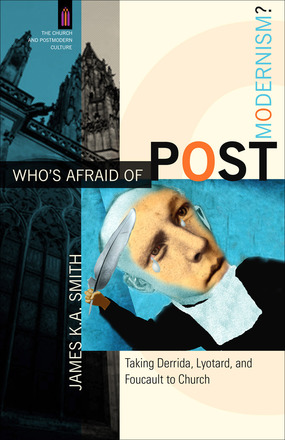
Taking Derrida, Lyotard, and Foucault to Church. James K. A. Smith (Baker Publishing Group, 2009).
As part of his Doctor of Ministry (DMin) in Ministry to Emerging Generations (Gordon-Conwell Theological Seminary), Tom’s written a number of book responses and given several short presentations (personal and group). In this series he not only “shares the wealth,” but also looks forward to your feedback as he refines his project: An argument for vocational discernment for graduate studies in the context of InterVarsity Christian Fellowship (Stay tuned to learn more!). Earlier posts on the program: Ministry to Emerging Generations and The Big Picture of Ministry to Emerging Generations.
Who’s Afraid of Postmodernism?Taking Derrida, Lyotard, and Foucault to Church
I read James K.A. Smith’s Who’s Afraid of Postmodernism?Taking Derrida, Lyotard, and Foucault to Church (Grand Rapids, MI: Baker Press, 2006) with the “eyes of a child,” smiling cover to cover. As one who dabbled in postmodernism and continues to enjoy the incarnational, global lingua franca of film (24), I valued the opportunity to become more fully oriented to the world of postmodernism as a lay person, i.e., not attempting to be a philosopher. In addition, I prized the Schaefferian approach (27-28, 74) to equip me not only as a campus minister, but also as a parent of four children (105). Truly the church is an apologetic in which one is renewed and transformed by God as part of a people living in a disciplined, liturgical community (28-30, 25, 99) across particular times and places to interact with “the lens of an interpretive framework governed by ultimate beliefs” through the Scriptures by the sanctification of the Spirit (54-56).
But it is hard for resource books exploring Christ and culture to keep pace with current media offerings. This struck me as The Matrix (1999) served as a bridge to Chapter 1’s exploration of Plato’s cave (15-18) [1]. Annotated Bibliographies (147- 150) and Online Resources (151-152) likewise grow old too quickly. All of these areas require additional research, possibly a Baker Press or James K.A. Smith website with periodic updates to keep the material relevant.
On a deeper level, although the frustration of young adulthood may at times be similar to Neo in The Matrix, the reality of the 2008 economic downturn broke a significant part of the postmodern bubble sustained by middle class parents for their children. As such the deeper existential search, which has not been as prevalent in the United States as in 20th Century Europe ravaged by two world wars, is not as widespread. In the end, I think that it is extremely hard to break American pragmatic consumerism (40-42, 92, 104-107). This being the case, I consider popular American postmodernism not as developed as Smith infers. In the end, I find it little more than an “intensification of modernism” with the shared emphasis upon “an idolatrous notion of self-sufficiency and naturalism” (26) and the questioning of reality most pertinent to academics and writers without direct interactions with the creation through the sciences (applied and research).
No matter how one frames the conversation, Smith is correct that the church in the U.S. has been behind in engaging the philosophical shift of our day (17), inspired by notable French influences (19). In addition, I concur modernism is too strong in the American church (and Christian ministries) and postmodern ideas can point not only to the value of our ancient heritage (23), but also offer a prophetic, interpretative challenge to the dominant culture (51). Furthermore, Smith’s re-framing of postmodern “bumper sticker” slogans is invaluabe, one worth consideration by the Scholar’s Compass.
- “There is nothing outside the text” (Derrida),
- Postmodernism is “incredulity toward metanarratives” (Lyotard),
- “Power is knowledge” (Foucault) (21-22).
I am particularly interested in a case study retelling (or “reading”) and questioning of stories (e.g.., scientism, 62, 66) from different perspectives as Smith does in relationship to the interpretation of the cross with revelation informing the horizon for interaction with “the objective” (44-48).
As a final note, I am surprised that Smith does not explore the impact of the world wars in his analysis of the European development of the dark inner search of postmodernism. As for being able to see or understand beyond the text (e.g., Derrida, 38), the push of music, drugs, and alcohol were another part of the quest on both sides of the Atlantic which it would have been helpful to at least touch upon. Back to the proper interpretation of the grace-filled context of the community of the Body of Christ (52-53), one which reaches back into the rich pre-modern traditions of the catholic church – interpreting and acting well today (79) instead of seeking correlation (123-127).
To God be the glory!
[1] Other films current at the time of publication: Memento (2001) for Derrida, O Brother, Where Art Thou (2001) for Lyotard, and Whale Rider (2003) for Radical Orthodoxy. One Flew over the Cuckoo’s Nest (1975) is the classic film used for Foucault. Maybe The Matrix is now a “classic” film.
Tom enjoys daily conversations regarding living out the Biblical Story with his wife Theresa and their four girls, around the block, at Elizabethtown Brethren in Christ Church (where he teaches adult electives and co-leads a small group), among healthcare professionals as the Northeast Regional Director for the Christian Medical & Dental Associations (CMDA), and in higher ed as a volunteer with the Emerging Scholars Network (ESN). For a number of years, the Christian Medical Society / CMDA at Penn State College of Medicine was the hub of his ministry with CMDA. Note: Tom served with InterVarsity Christian Fellowship / USA for 20+ years, including 6+ years as the Associate Director of ESN. He has written for the ESN blog from its launch in August 2008. He has studied Biology (B.S.), Higher Education (M.A.), Spiritual Direction (Certificate), Spiritual Formation (M.A.R.), Ministry to Emerging Generations (D.Min.). To God be the glory!

Leave a Reply